NCERT Solved Exercise Questions – Class 12 Physics Chapter 11 Dual Nature Of Radiation And Matter
11.1 Find the
(a) maximum frequency, and
(b) minimum wavelength of X-rays produced by 30 kV electrons.
Ans – The electrons’ potential is V = 30 kV = 3 x104 V.
Consequently, the electrons’ energy is E = 3 x104 eV.
Where,
1.6 x10^-19 C is the charge on an electron, or e.

11.2 The work function of caesium metal is 2.14 eV. When light of frequency 6 ×1014Hz is incident on the metal surface, photoemission of electrons occurs. What is the
(a) maximum kinetic energy of the emitted electrons,
(b) Stopping potential, and
(c) maximum speed of the emitted photoelectrons?
Ans – Work function of caesium , ![]()
Frequency of light


11.3 The photoelectric cut-off voltage in a certain experiment is 1.5 V. What is the maximum kinetic energy of photoelectrons emitted?
Ans –Maximum kinetic energy of the electrons that were released,

11.4 Monochromatic light of wavelength 632.8 nm is produced by a helium-neon laser. The power emitted is 9.42 mW.
(a) Find the energy and momentum of each photon in the light beam,
(b) How many photons per second, on the average, arrive at a target irradiated by this beam? (Assume the beam to have uniform cross-section which is less than the target area), and (c) How fast does a hydrogen atom have to travel in order to have the same momentum as that of the photon?
Ans – Wavelength of the monochromatic light, λ = 632.8 nm = 632.8 × 10−9 m
Power emitted by the laser, P = 9.42 mW = 9.42 × 10−3 W
Planck’s constant, h = 6.626 × 10−34 Js
(a) Energy of each photon,


11.5 The energy flux of sunlight reaching the surface of the earth is 1.388 × 103 W/m2 . How many photons (nearly) per square metre are incident on the Earth per second? Assume that the photons in the sunlight have an average wavelength of 550 nm.
Ans – Sunlight energy flux at the earth’s surface is 1.388 x 103 W/m2.
Consequently, P = 1.388 x 103 W is the power of sunlight per square metre.
Light-speed formula: c = 3 x 108 m/s

11.6 In an experiment on photoelectric effect, the slope of the cut-off voltage versus frequency of incident light is found to be 4.12 × 10–15 V s. Calculate the value of Planck’s constant.
Ans – The following equation represents the slope of the cut-off voltage (V) versus frequency (v) of an incoming light:

11.7 A 100W sodium lamp radiates energy uniformly in all directions. The lamp is located at the centre of a large sphere that absorbs all the sodium light which is incident on it. The wavelength of the sodium light is 589 nm.
(a) What is the energy per photon associated with the sodium light?
(b) At what rate are the photons delivered to the sphere?
Ans – P = 100 W is the sodium lamp’s power.
The sodium light’s wavelength is 589 nm, or 589 x 10^-9 m.
h = 6.626 x10^-34 Js, the Planck constant

11.8 The threshold frequency for a certain metal is 3.3 × 1014 Hz. If light of frequency 8.2 × 1014 Hz is incident on the metal, predict the cutoff voltage for the photoelectric emission.
Ans – Cut-off voltage for the metal’s photoelectric emission is V.
The following is the equation for the cut-off energy:

11.9 The work function for a certain metal is 4.2 eV
. Will this metal give photoelectric emission for incident radiation of wavelength 330 nm?
Ans – Light-speed formula: c = 3 x 10^8 m/s
The incident photon’s energy is given as:
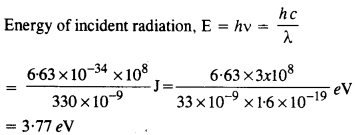
Since the energy of the incident photons, 3.77 eV, is less than the work function, there won’t be any emission.
11.10 Light of frequency 7.21 × 1014 Hz is incident on a metal surface. Electrons with a maximum speed of 6.0 × 105 m/s are ejected from the surface. What is the threshold frequency for photoemission of electrons?
Ans – An electron’s mass is 9.1 x 10^-31 kilogrammes.
The relationship for kinetic energy is expressed as follows for threshold frequency v0:

11.11 Light of wavelength 488 nm is produced by an argon laser which is used in the photoelectric effect. When light from this spectral line is incident on the emitter, the stopping (cut-off) potential of photoelectrons is 0.38 V. Find the work function of the material from which the emitter is made.
Ans – Lightspeed, c = 3 x 10 m/s
We can deduce the following relationship involving the work function 0 of the emitter material from Einstein’s photoelectric effect:

11.12 Calculate the
(a) momentum, and
(b) de Broglie wavelength of the electrons accelerated through a potential difference of 56 V.
Ans – A 56 V potential difference will accelerate an electron, giving it kinetic energy K = 56 eV.
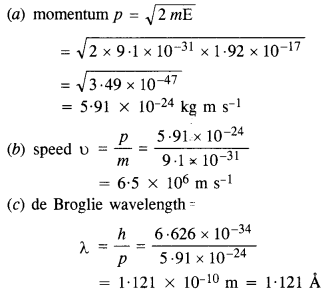
11.13 What is the
(a) momentum,
(b) speed, and
(c) de Broglie wavelength of an electron with kinetic energy of 120 eV.
Ans – An electron’s charge is equal to 1.6 x 10^-19 C.
The kinetic energy relation for the electron is as follows:
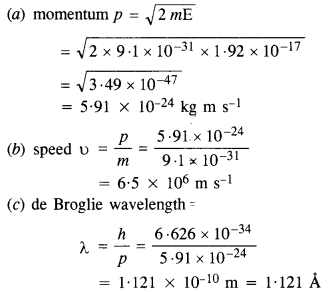
11.14 The wavelength of light from the spectral emission line of sodium is 589 nm. Find the kinetic energy at which
(a) an electron, and
(b) a neutron, would have the same de Broglie wavelength.
Ans – The amount of kinetic energy needed for an electron to have a 589 nm de-Broglie wavelength
Mass of a neutron, mn= 1.66 × 10−27 kg
Planck’s constant, h = 6.6 × 10−34 Js
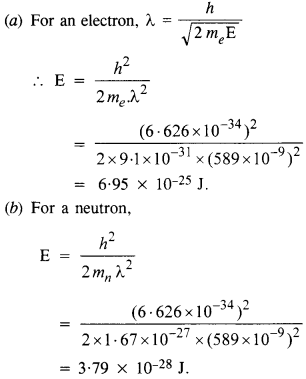
11.15 What is the de Broglie wavelength of
(a) a bullet of mass 0.040 kg travelling at the speed of 1.0 km/s, (b) a ball of mass 0.060 kg moving at a speed of 1.0 m/s, and
(c) a dust particle of mass 1.0 × 10–9 kg drifting with a speed of 2.2 m/s?
Ans – (a) Bullet-related wave length

(b) The ball’s related wavelength

(c) The dust particle’s related wave length

11.16 An electron and a photon each have a wavelength of 1.00 nm. Find
(a) their momenta,
(b) the energy of the photon, and
(c) the kinetic energy of electron.
Ans –
h = 6.63 x 10^-34 Js,
the Planck constant
(A) The de Broglie relation provides the momentum of an elementary particle.

11.17 (a) For what kinetic energy of a neutron will the associated de Broglie wavelength be 1.40 × 10–10 m?
(b) Also find the de Broglie wavelength of a neutron, in thermal equilibrium with matter, having an average kinetic energy of (3/2) k T at 300 K.
Ans –
Neutron mass, mn, is 1.66 x10^-27 kg.
The Planck constant is 6.6 x 10^-34 Js.
Velocity (v) and kinetic energy (K) are connected as follows:

11.18 Show that the wavelength of electromagnetic radiation is equal to the de Broglie wavelength of its quantum (photon).
Ans – Where,
λ = The electromagnetic radiation’s wavelength
c = Lightspeed
Planck’s constant is h.
The photon’s De Broglie wavelength is given as:

11.19 What is the de Broglie wavelength of a nitrogen molecule in air at 300 K? Assume that the molecule is moving with the root-meansquare speed of molecules at this temperature. (Atomic mass of nitrogen = 14.0076 u)
Ans – The nitrogen molecule’s temperature is 300 K.
Nitrogen’s atomic mass is 14.0076 u.
Therefore, the nitrogen molecule’s mass is given by m = 2 x 14.0076 = 28.0152 u.

11.20 (a) Estimate the speed with which electrons emitted from a heated emitter of an evacuated tube impinge on the collector maintained at a potential difference of 500 V with respect to the emitter. Ignore the small initial speeds of the electrons. The specific charge of the electron, i.e., its e/m is given to be 1.76 × 1011 C kg–1.
(b) Use the same formula you employ in (a) to obtain electron speed for an collector potential of 10 MV. Do you see what is wrong ? In what way is the formula to be modified?
Ans – This electron speed is not feasible. Nothing can go faster than light, which has a speed of 3x 18 metres per second.
Only for v « c is the kinetic energy expression
E = 1/2 mv2 valid.
We employ the relativistic formula in the case where speed v is similar to the speed of light c.

11.21 (a) A monoenergetic electron beam with electron speed of 5.20 × 106 m s–1 is subject to a magnetic field of 1.30 × 10–4 T normal to the beam velocity. What is the radius of the circle traced by the beam, given e/m for electron equals 1.76 × 1011C kg–1.
(b) Is the formula you employ in (a) valid for calculating radius of the path of a 20 MeV electron beam? If not, in what way is it modified? [Note: Exercises 11.20(b) and 11.21(b) take you to relativistic mechanics which is beyond the scope of this book. They have been inserted here simply to emphasise the point that the formulas you use in part (a) of the exercises are not valid at very high speeds or energies. See answers at the end to know what ‘very high speed or energy’ means.]
Ans –

The electron beam needs centripetal force in order to follow a circular route, which the normal magnetic field gives it. Centripetal force caused by a magnetic field on an electron is therefore equal to force on an electron.

At very high energies, the circular path radius formula is invalid due of the enormous energy

11.22 An electron gun with its collector at a potential of 100 V fires out electrons in a spherical bulb containing hydrogen gas at low pressure (∼10–2 mm of Hg). A magnetic field of 2.83 × 10–4 T curves the path of the electrons in a circular orbit of radius 12.0 cm. (The path can be viewed because the gas ions in the path focus the beam by attracting electrons, and emitting light by electron capture; this method is known as the ‘fine beam tube’ method.) Determine e/m from the data.
Ans – Each electron has a mass of m.
Each electron’s charge equals e.
Each electron has a velocity of v.
Each electron has an energy equal to its kinetic energy, or

11.23 (a) An X-ray tube produces a continuous spectrum of radiation with its short wavelength end at 0.45 Å. What is the maximum energy of a photon in the radiation?
(b) From your answer to (a), guess what order of accelerating voltage (for electrons) is required in such a tube?
Ans –
h = 6.626 x 10^-34 Js, the Planck constant
Light-speed formula: c = 3 x 108 m/s
A photon’s maximal energy is expressed as

The incident electrons striking the surface should have higher energy, i.e., on the order of 30 keV, in order for the surface to release photons with an energy of 27.6 keV.
11.24 In an accelerator experiment on high-energy collisions of electrons with positrons, a certain event is interpreted as annihilation of an electron-positron pair of total energy 10.2 BeV into two γ-rays of equal energy. What is the wavelength associated with each γ-ray? (1BeV = 109 eV)
Ans – Both of the created y ray photons share the whole energy of the electron-positron pair upon annihilation. Energy of two y-rays equals 10.2 BeV for an electron-positron pair.

11.25 Estimating the following two numbers should be interesting. The first number will tell you why radio engineers do not need to worry much about photons! The second number tells you why our eye can never ‘count photons’, even in barely detectable light.
(a) The number of photons emitted per second by a Medium wave transmitter of 10 kW power, emitting radiowaves of wavelength 500 m.
(b) The number of photons entering the pupil of our eye per second corresponding to the minimum intensity of white light that we humans can perceive (∼10–10 W m–2). Take the area of the pupil to be about 0.4 cm2 , and the average frequency of white light to be about 6 × 1014 Hz.
Ans – (a)Power of the transmitter here,

really little and a radio beam emits a vast amount of photons per second. Therefore, there is very little inaccuracy involved in considering the total energy of a radio wave as continuous and ignoring the presence of a minimum quantum of energy (photon).
(b) In this instance, the pupillary area is A = 0.4 cm2 = 0.4 10-4 m2, and v = 6 1014 Hz. Efficacy = 10-10 W m-2
The energy per unit area attributable to these photons is equal to the total energy of n photons, which is equal to n 4 10-19 J nr2 if n is the number of photons falling per second per unit area. Given that intensity equals energy per square metre per second10−10=n×4×10−19
n=10−104×10−19=2.5×108m−2s−2
∴ Number of photons entering the pupil per second = n x area of the pupil = 2.5 × 108 × 0.4 × 10-4 s-1 = 104 s-1.
Though this number is not large as in part (a) above, it is large enough for us to ‘sense’ or ‘count’ the individual photons by our eye.
11.26 Ultraviolet light of wavelength 2271 Å from a 100 W mercury source irradiates a photo-cell made of molybdenum metal. If the stopping potential is –1.3 V, estimate the work function of the metal. How would the photo-cell respond to a high intensity (∼105 W m–2) red light of wavelength 6328 Å produced by a He-Ne laser?
Ans – Light frequency equals v.
The photo-energy relation resulting from the photoelectric effect is as follows:

11.27 Monochromatic radiation of wavelength 640.2 nm (1nm = 10–9 m) from a neon lamp irradiates photosensitive material made of caesium on tungsten. The stopping voltage is measured to be 0.54 V. The source is replaced by an iron source and its 427.2 nm line irradiates the same photo-cell. Predict the new stopping voltage.
Ans – Neon bulb stopping potential, V0 = 0.54 V
An electron’s charge is equal to 1.6 x 10^-19 C.

11.28 A mercury lamp is a convenient source for studying frequency dependence of photoelectric emission, since it gives a number of spectral lines ranging from the UV to the red end of the visible spectrum. In our experiment with rubidium photo-cell, the following lines from a mercury source were used:
λ1 = 3650 Å, λ2= 4047 Å, λ3= 4358 Å, λ4= 5461 Å, λ5= 6907 Å, The stopping voltages, respectively, were measured to be: V01 = 1.28 V, V02 = 0.95 V, V03 = 0.74 V, V04 = 0.16 V, V05 = 0 V Determine the value of Planck’s constant h, the threshold frequency and work function for the material. [Note: You will notice that to get h from the data, you will need to know e (which you can take to be 1.6 × 10–19 C). Experiments of this kind on Na, Li, K, etc. were performed by Millikan, who, using his own value of e (from the oil-drop experiment) confirmed Einstein’s photoelectric equation and at the same time gave an independent estimate of the value of h.]
Ans –We need the slope of the graph between cut off voltage and frequency to determine Planck’s constant, ll. In order to determine the stopping potential in each situation, let’s first determine the frequency (u = c/λ).

The first four spots on the V0 versus n plot are almost exactly on a straight line that crosses the x-axis at the threshold frequency, u0 = 5.0 1014 Hz. Since u u0 corresponds to the fifth point (u = 4.3 1014 Hz), there is no photoelectric emission and no stopping voltage is needed to stop the current. V0 vs u graph’s slope is


(b) threshold frequency, 5.0 x 1014 J

11.29 The work function for the following metals is given: Na: 2.75 eV; K: 2.30 eV; Mo: 4.17 eV; Ni: 5.15 eV. Which of these metals will not give photoelectric emission for a radiation of wavelength 3300 Å from a He-Cd laser placed 1 m away from the photocell? What happens if the laser is brought nearer and placed 50 cm away?
Ans –

Mo and Ni metals won’t undergo photoelectric emission since the incident photon’s energy E is smaller than their work functions. The energy of the photons of the light incident does not change with source distance, and as a result, neither will the energy of the electrons ejected. However, the intensity of the ejected electrons will grow (1 1/r2) and become four times as strong.
11.30 Light of intensity 10–5 W m–2 falls on a sodium photo-cell of surface area 2 cm2 . Assuming that the top 5 layers of sodium absorb the incident energy, estimate time required for photoelectric emission in the wave-picture of radiation. The work function for the metal is given to be about 2 eV. What is the implication of your answer?
Ans – According to the wave model of radiation, incident energy is continuously and evenly dispersed across all of the electrons. Let’s first determine how many recipient electrons there are overall in five layers of sodium. Take into account that each sodium atom has one free conduction electron. 10–20 m2 is the effective atomic area. Conduction electron count in 5 layers

11.31 Crystal diffraction experiments can be performed using X-rays, or electrons accelerated through appropriate voltage. Which probe has greater energy? (For quantitative comparison, take the wavelength of the probe equal to 1 Å, which is of the order of inter-atomic spacing in the lattice) (me=9.11 × 10–31 kg).
Ans – In the crystal lattice, the interatomic spacing is in the order 1A. Therefore, the wavelength must be the same for diffraction to occur. order. X-ray photon (energy for wavelength of 1 A)
Mass of an electron, me = 9.11 × 10−31 kg
Planck’s constant, h = 6.6 × 10−34 Js
Charge on an electron, e = 1.6 × 10−19 C
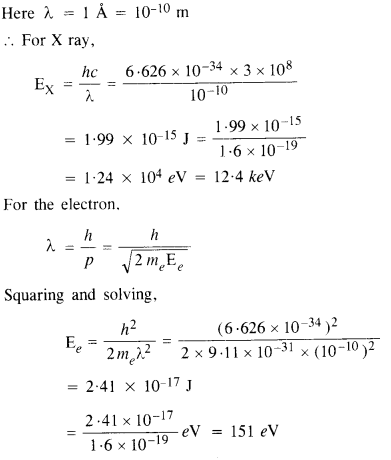
11.32 (a) Obtain the de Broglie wavelength of a neutron of kinetic energy 150 eV. As you have seen in Exercise 11.31, an electron beam of this energy is suitable for crystal diffraction experiments. Would a neutron beam of the same energy be equally suitable? Explain. (mn = 1.675 × 10–27 kg).
(b) Obtain the de Broglie wavelength associated with thermal neutrons at room temperature (27 °C). Hence explain why a fast neutron beam needs to be thermalised with the environment before it can be used for neutron diffraction experiments.
Ans – (a) First, let’s determine the wavelength of the matter wave connected to the 150 eV neutron.

A neutron beam with an energy of 150 eV is not suited for diffraction investigations since the interatomic distance (1 A= 10-10 m) is hundreds of times greater than this wavelength.
(b) A neutron’s average kinetic energy at absolute zero temperature T equals


The wavelength of thermal neutrons is equivalent to the atomic distance between atoms in a crystal (= 1 A), making them suitable for diffraction research. Therefore, before using a high energy neutron beam for diffraction, it should first be thermalized.
11.33 An electron microscope uses electrons accelerated by a voltage of 50 kV. Determine the de Broglie wavelength associated with the electrons. If other factors (such as numerical aperture, etc.) are taken to be roughly the same, how does the resolving power of an electron microscope compare with that of an optical microscope which uses yellow light?
Ans – The kinetic energy of the electron is given as:
E = eV
= 1.6 × 10−19 × 50 × 103
= 8 × 10−15 J
De Broglie wavelength is given by the relation:

11.34 The wavelength of a probe is roughly a measure of the size of a structure that it can probe in some detail. The quark structure of protons and neutrons appears at the minute length-scale of 10–15 m or less. This structure was first probed in early 1970’s using high energy electron beams produced by a linear accelerator at Stanford, USA. Guess what might have been the order of energy of these electron beams. (Rest mass energy of electron = 0.511 MeV.)
Ans –

Second term demonstrating the insignificance of rest mass energy. E = 1.989 x 10-10 J = 1.24 BeV for energy. Therefore, the electron’s obtained energy from the specified accelerator must have been in the range of a few BeV.
11.35 Find the typical de Broglie wavelength associated with a He atom in helium gas at room temperature (27 °C) and 1 atm pressure; and compare it with the mean separation between two atoms under these conditions.
Ans – Atmospheric pressure, P = 1 atm = 1.01 × 105 Pa
Atomic weight of a He atom = 4
Avogadro’s number, NA = 6.023 × 1023

11.36 Compute the typical de Broglie wavelength of an electron in a metal at 27 °C and compare it with the mean separation between two electrons in a metal which is given to be about 2 × 10–10 m. [Note: Exercises 11.35 and 11.36 reveal that while the wave-packets associated with gaseous molecules under ordinary conditions are non-overlapping, the electron wave-packets in a metal strongly overlap with one another. This suggests that whereas molecules in an ordinary gas can be distinguished apart, electrons in a metal cannot be distintguished apart from one another. This indistinguishibility has many fundamental implications which you will explore in more advanced Physics courses.]
Ans – T = 27°C, which is equal to 27 + 273 = 300 K.
The average distance between two electrons is r = 2 x 10^-10 m.
The electron’s De Broglie wavelength is given as:

11.37 Answer the following questions:
(a) Quarks inside protons and neutrons are thought to carry fractional charges [(+2/3)e ; (–1/3)e]. Why do they not show up in Millikan’s oil-drop experiment?
(b) What is so special about the combination e/m? Why do we not simply talk of e and m separately?
(c) Why should gases be insulators at ordinary pressures and start conducting at very low pressures?
(d) Every metal has a definite work function. Why do all photoelectrons not come out with the same energy if incident radiation is monochromatic? Why is there an energy distribution of photoelectrons?
(e) The energy and momentum of an electron are related to the frequency and wavelength of the associated matter wave by the relations: E = h ν, p = λ h But while the value of λ is physically significant, the value of ν (and therefore, the value of the phase speed ν λ) has no physical significance. Why?
Ans – (a) It is believed that a proton and a neutron are where the quarks with fractional charges are contained. There are forces that bind these quarks. When the quarks are attempted to be pulled apart, these forces get greater. The quarks constantly stay together because of this. This explains why, despite the fact that fractional charges may occur in nature, visible charges are always integral multiples of the charge of an electron.
(b) The fundamental equations relate the travel of the electron in the electric and magnetic fields
There is no equation in which e or m appear separately; instead, all of these equations involve both variables simultaneously. Because of this, we analyse the e/m of the electron rather than discussing e and m independently for an electron.
(c) Gas molecules continually collide with one another at atmospheric pressure, and the ions that result from these collisions are recombined before they have a chance to reach the appropriate electrodes and produce a current. However, under low pressure, ions rarely collide and can go to the appropriate electrodes to form a current.
The energy needed to remove an electron from an emitter’s highest filled level of the conduction band is known as the work function
(d) There are several energy levels that together make up a continuous band of levels in the conduction band. As a result, different amounts of energy are needed to remove the electrons from various levels. Depending on the energy source, the released electrons have various kinetic energies.
(e) Within the additive constant, a particle’s absolute energy value is arbitrary. As a result, the wavelength () is important whereas the electron’s associated frequency (v) has no direct physical meaning.
Because of this, the product (phase speed) has no physical meaning.
Class 12 Physics Chapter 11 Dual Nature Of Radiation And Matter Solved Exercise Questions Free PDF Download





